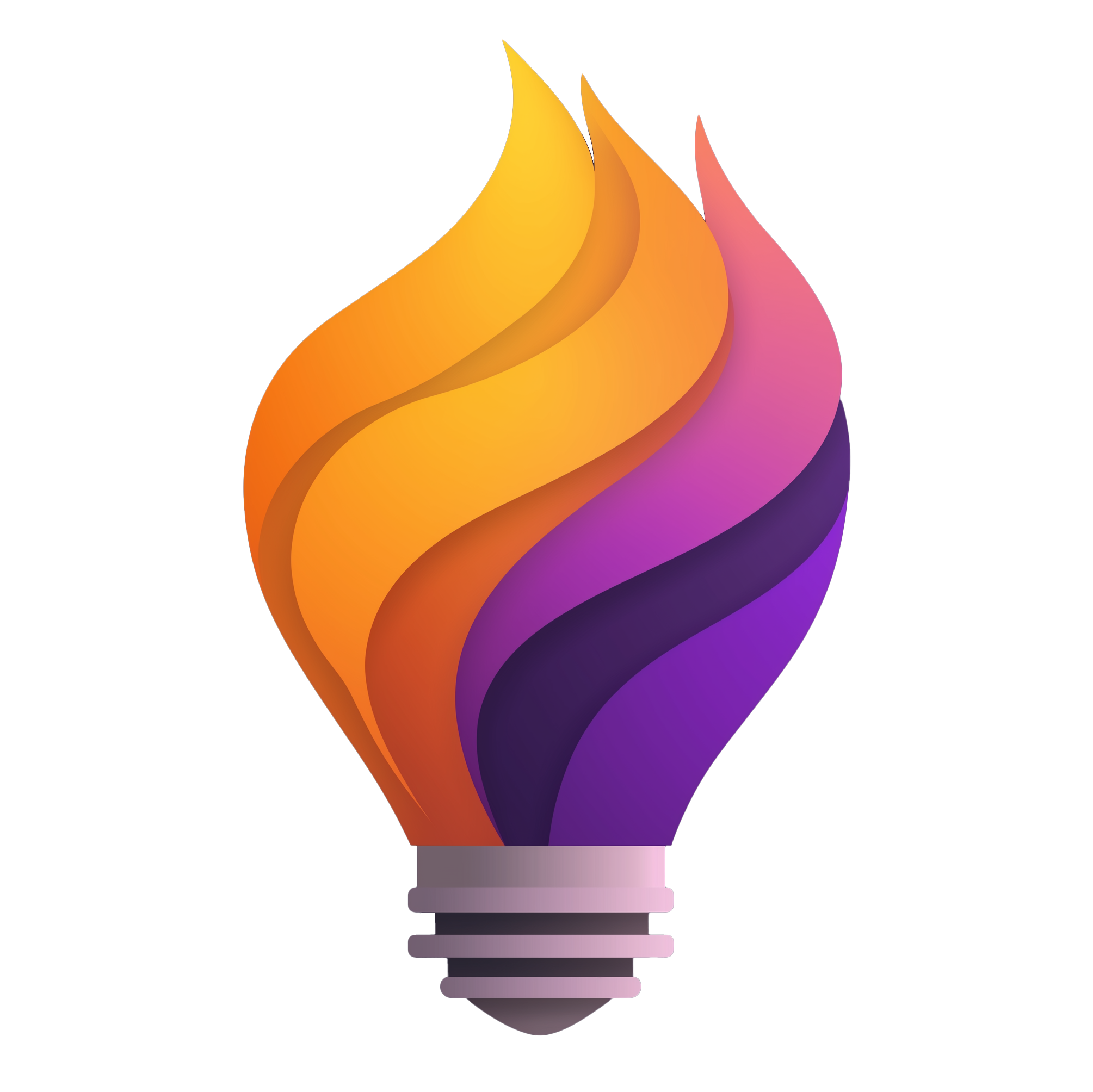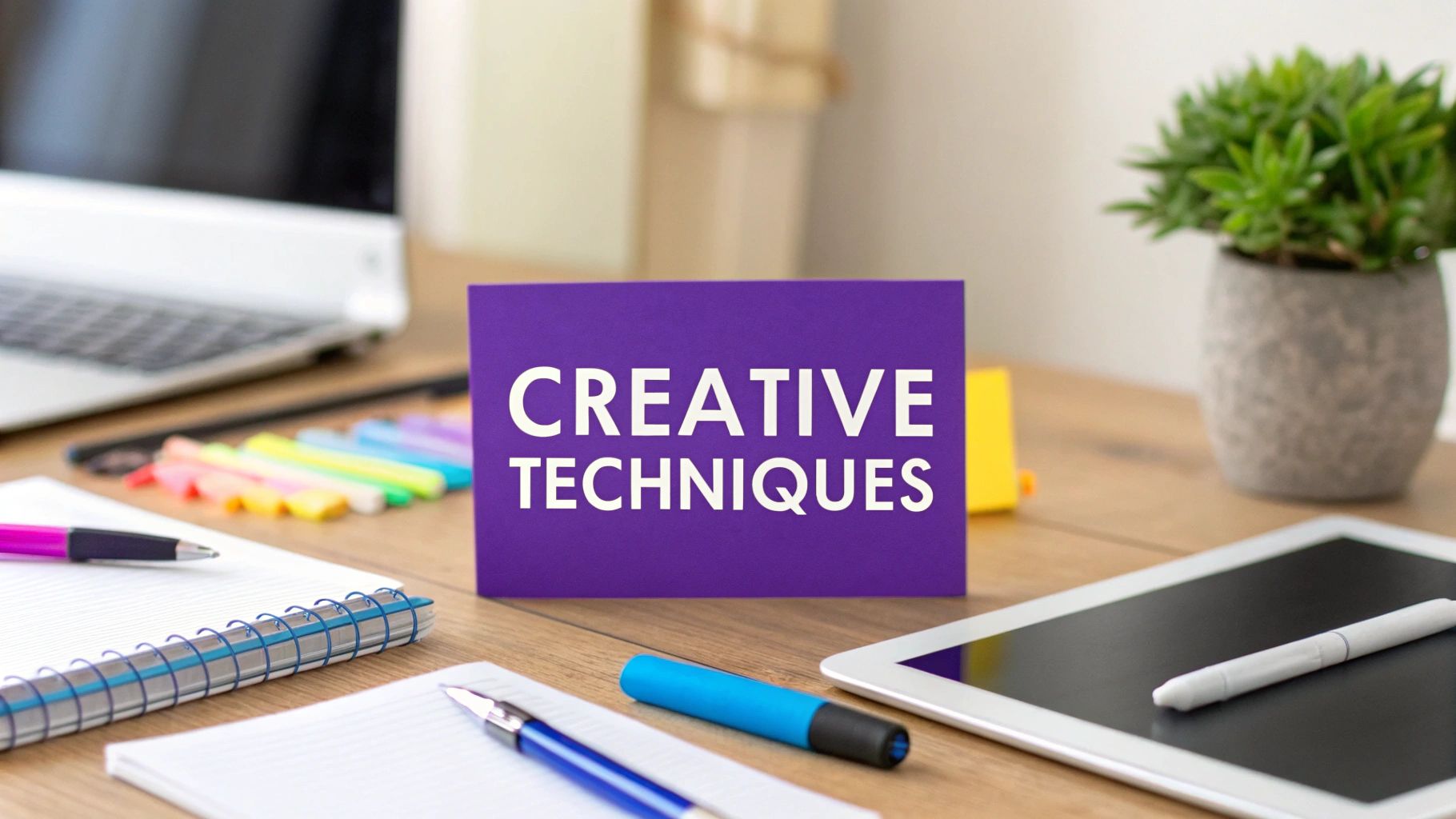Creativity isn't just a spark of inspiration; it's a skill that can be developed and a process that can be structured. For remote and hybrid teams, simply gathering in a virtual room and "brainstorming" often leads to the same tired ideas. The real challenge isn't a lack of talent, but a lack of effective methods to channel that talent. Relying on unstructured sessions is like trying to build a house without a blueprint. You might get something, but it won't be optimized, efficient, or particularly innovative.
This article moves past the abstract and dives straight into actionable frameworks. We will break down ten powerful techniques for creativity, each designed to help your team systematically approach problems and generate novel solutions. For every technique, you'll find a clear explanation of what it is, why it works, and specific steps to implement it in your next remote workshop. Forget vague advice and get ready to equip your team with a toolkit that transforms how you innovate, solve complex challenges, and unlock your true creative potential. We'll show you not just what to do, but exactly how to do it.
1. Brainstorming
Brainstorming is a foundational technique for creativity where a group collaboratively generates a large volume of ideas in a short period. The core principle, developed by advertising executive Alex Osborn, is to strictly separate idea generation from evaluation. This judgment-free environment encourages participants to share wild, unconventional thoughts, which often serve as catalysts for more practical, innovative solutions.

This method’s power lies in its ability to unlock collective thinking and build momentum. As one person shares an idea, it sparks new connections for others, leading to a chain reaction of creativity. Design firm IDEO famously uses structured brainstorming to develop groundbreaking products, while the accidental invention of 3M’s Post-it Notes emerged from a similar process of open-ended idea generation.
How to Implement Brainstorming with Your Remote Team
To effectively run a brainstorming session, focus on structure and psychological safety. This is especially crucial for distributed teams to ensure everyone feels comfortable contributing.
- Set a Clear Focus: Define a specific problem or question before the session begins. For example, instead of a vague "how to improve our app," use a focused prompt like, "What are three unconventional features we could add to increase user engagement by 10%?"
- Assign a Facilitator: A neutral facilitator keeps the session on track, manages time, and ensures all voices are heard. Their role is to gently redirect criticism and maintain a high-energy, positive atmosphere.
- Emphasize Quantity Over Quality: The initial goal is to generate as many ideas as possible. Remind the team to defer all judgment. No idea is too strange or impractical during the generation phase.
- Schedule Evaluation Separately: Plan a follow-up meeting to review, categorize, and evaluate the generated ideas. This separation is key to preserving the creative flow.
2. Mind Mapping
Mind mapping is a visual thinking technique that helps structure information, analyze complex problems, and generate new ideas. Popularized by Tony Buzan, this method starts with a central concept and radiates outwards into associated sub-topics and keywords. This non-linear, hierarchical structure mimics the brain's natural associative thought processes, making it one of the most intuitive techniques for creativity.
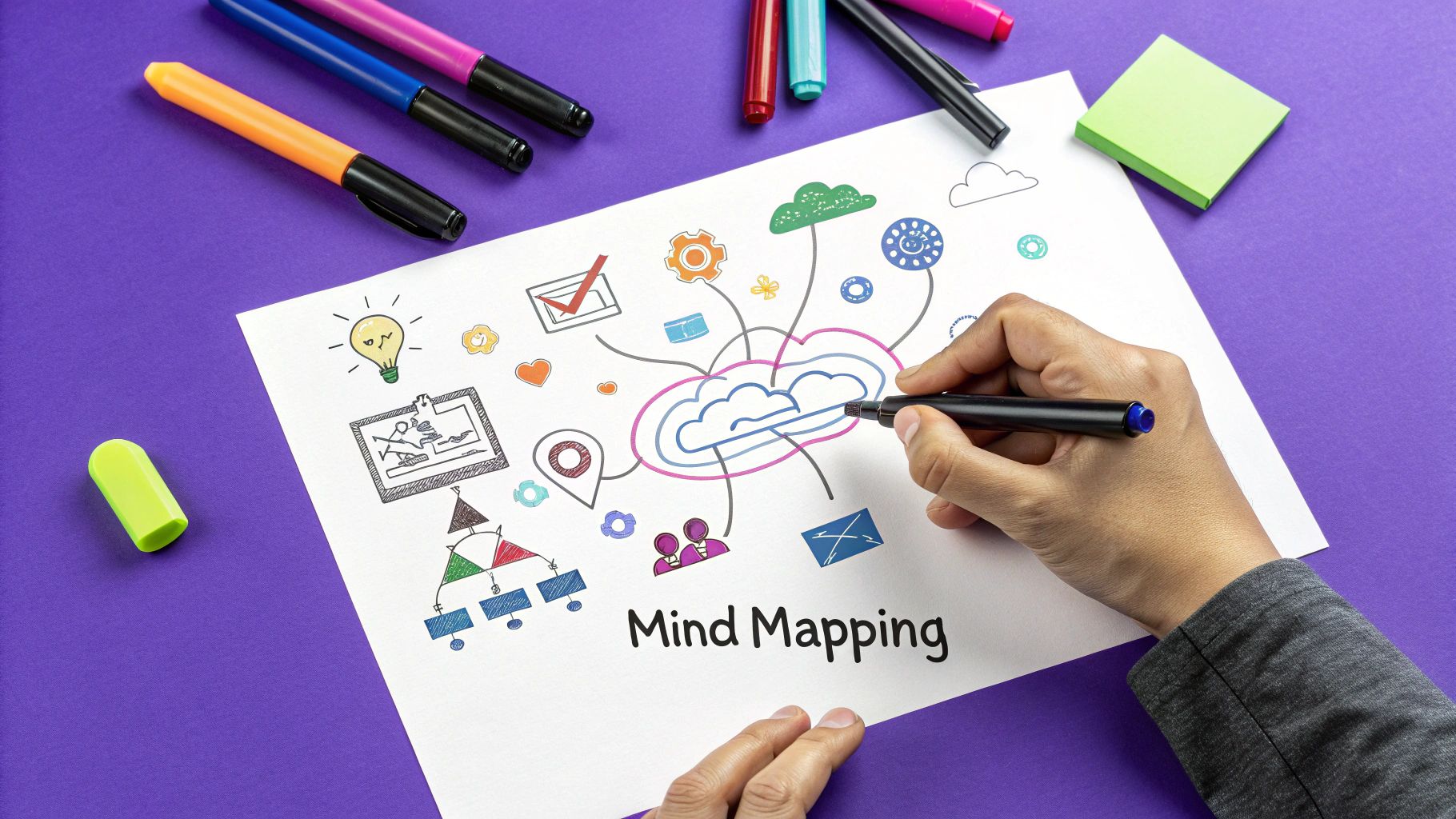
Its power lies in transforming a list of monotonous information into a colorful, memorable, and highly organized diagram that works in line with your brain's natural way of doing things. For instance, Boeing engineers reportedly used mind maps in the design process for the complex 747 aircraft. Similarly, writers use it for plot development, and business consultants rely on it for strategic planning, demonstrating its versatility. For a deeper look, you can learn more about brainstorming and mind mapping on remotesparks.com.
How to Implement Mind Mapping with Your Remote Team
Using digital whiteboards, remote teams can collaboratively build mind maps to unlock shared understanding and spark innovation. A structured approach ensures the session is productive and inclusive.
- Start with a Central Idea: Place a single, clear concept at the center of your digital canvas. This could be a problem statement, a project goal, or a core topic. For example, "New Q3 Marketing Campaign."
- Use Colors and Images: Assign a different color to each primary branch radiating from the center. Encourage team members to use icons, symbols, and images to make connections more memorable and stimulate creative thinking.
- Keep Text Concise: Use single keywords or very short phrases on each branch. The goal is to capture the essence of an idea, not write full sentences. This keeps the map clean and easy to scan.
- Encourage Free Association: Let the team add branches and sub-branches freely without initial judgment. The aim is to explore all possible connections, even those that seem tangential at first.
3. SCAMPER Technique
The SCAMPER technique is a structured creative thinking method that uses a checklist of seven prompts to examine existing ideas, products, or challenges from new angles. Popularized by Bob Eberle, this tool encourages you to ask targeted questions to manipulate and transform a concept. Each letter represents a prompt: Substitute, Combine, Adapt, Modify, Put to another use, Eliminate, and Reverse.
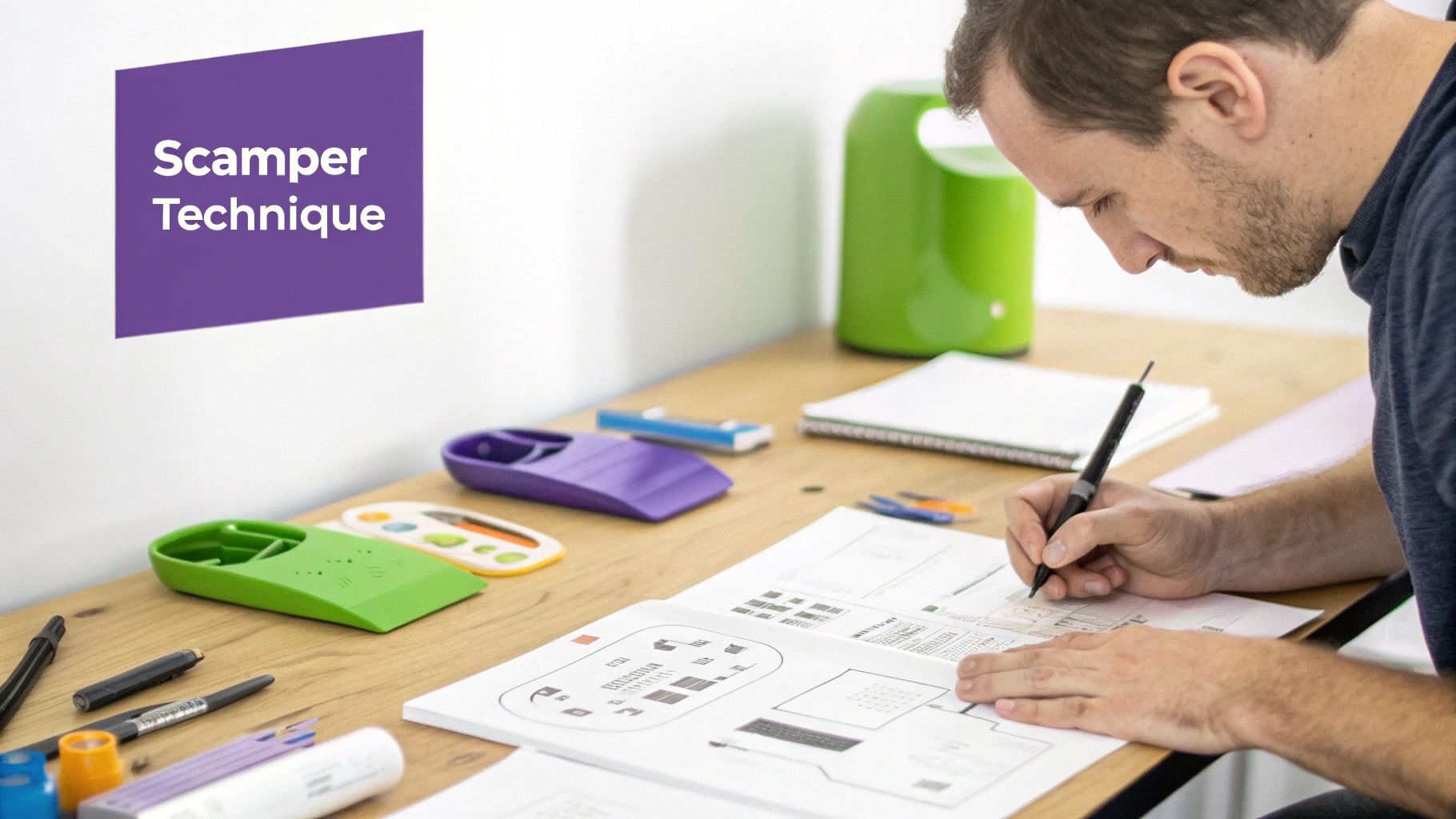
This method’s strength lies in its systematic approach, which prevents teams from getting stuck and ensures all possibilities are explored. For instance, McDonald's Adapted the drive-through concept from the banking industry, while Dyson Modified the traditional vacuum cleaner by eliminating the bag. It forces a deliberate exploration of modifications, making it one of the most effective techniques for creativity when innovating on something that already exists.
How to Implement the SCAMPER Technique with Your Remote Team
SCAMPER is excellent for remote workshops as its structured nature keeps everyone focused and moving forward. It provides a clear roadmap for deconstructing a problem.
- Define Your Focus: Start with a clear product, service, or process you want to improve. For example, "How can we apply SCAMPER to our customer onboarding flow?"
- Work Through Each Letter Systematically: Dedicate time for your team to generate ideas for each of the seven prompts. Use a digital whiteboard where everyone can add their thoughts under the appropriate letter.
- Encourage Cross-Industry Thinking: When at the "Adapt" or "Put to another use" stages, prompt the team to look at solutions from completely different industries. How would a gaming company solve this problem? What about a hospitality brand?
- Combine and Refine Ideas: After generating ideas for each letter, look for powerful combinations. A great solution might emerge from combining an "Eliminate" idea with a "Substitute" concept.
4. Six Thinking Hats
Six Thinking Hats is a parallel thinking technique that guides a group to explore an idea from multiple perspectives in a structured way. Developed by Edward de Bono, this method assigns six colored "hats," each representing a specific mode of thinking. By having everyone wear the same "hat" at the same time, the group avoids conflict and ensures all angles of a problem are considered systematically.
This powerful technique for creativity separates ego from performance, allowing teams to analyze issues more comprehensively. For instance, Motorola used this method to streamline product development decisions, while government agencies apply it to policy development. The process encourages participants to step outside their usual thinking patterns, fostering a more holistic and innovative approach to problem-solving.
How to Implement Six Thinking Hats with Your Remote Team
To use this method effectively in a remote setting, a clear structure and a strong facilitator are essential. This ensures the team stays focused and derives maximum value from each perspective.
- Assign a Facilitator: A facilitator is crucial for guiding the session, announcing hat switches, and keeping time. They ensure the discussion remains focused on the current hat's thinking mode.
- Clarify Each Hat's Role: Before starting, ensure everyone understands the hats: White (facts), Red (emotions), Black (cautions), Yellow (benefits), Green (creativity), and Blue (process).
- Sequence the Hats Strategically: The facilitator should plan the sequence of hats. A common flow is Blue (agenda), White (data), Green (ideas), Yellow (positives), Black (risks), Red (feelings), and Blue (summary).
- Use Visual Cues: In a virtual meeting, use colored banners, virtual backgrounds, or slide decks to visually indicate which hat is currently in use. This helps keep everyone aligned and focused on the correct mode of thinking. To get started, you can explore detailed exercises for groups like Six Thinking Hats.
5. Design Thinking
Design Thinking is a human-centered approach to innovation that integrates the needs of people, the possibilities of technology, and the requirements for business success. Popularized by firms like IDEO and the Stanford d.school, it uses a structured, five-stage process: Empathize, Define, Ideate, Prototype, and Test. This framework helps teams solve complex problems by focusing on the end-user's experience first.
This method’s power comes from its emphasis on empathy and rapid iteration. By deeply understanding user needs, teams can generate more relevant and impactful ideas. For example, Airbnb transformed its business by using Design Thinking to improve host-guest interactions, while Apple’s legendary product development process is rooted in a deep understanding of user desires and behaviors.
The Design Thinking process flow visualizes the core iterative cycle that drives innovation.
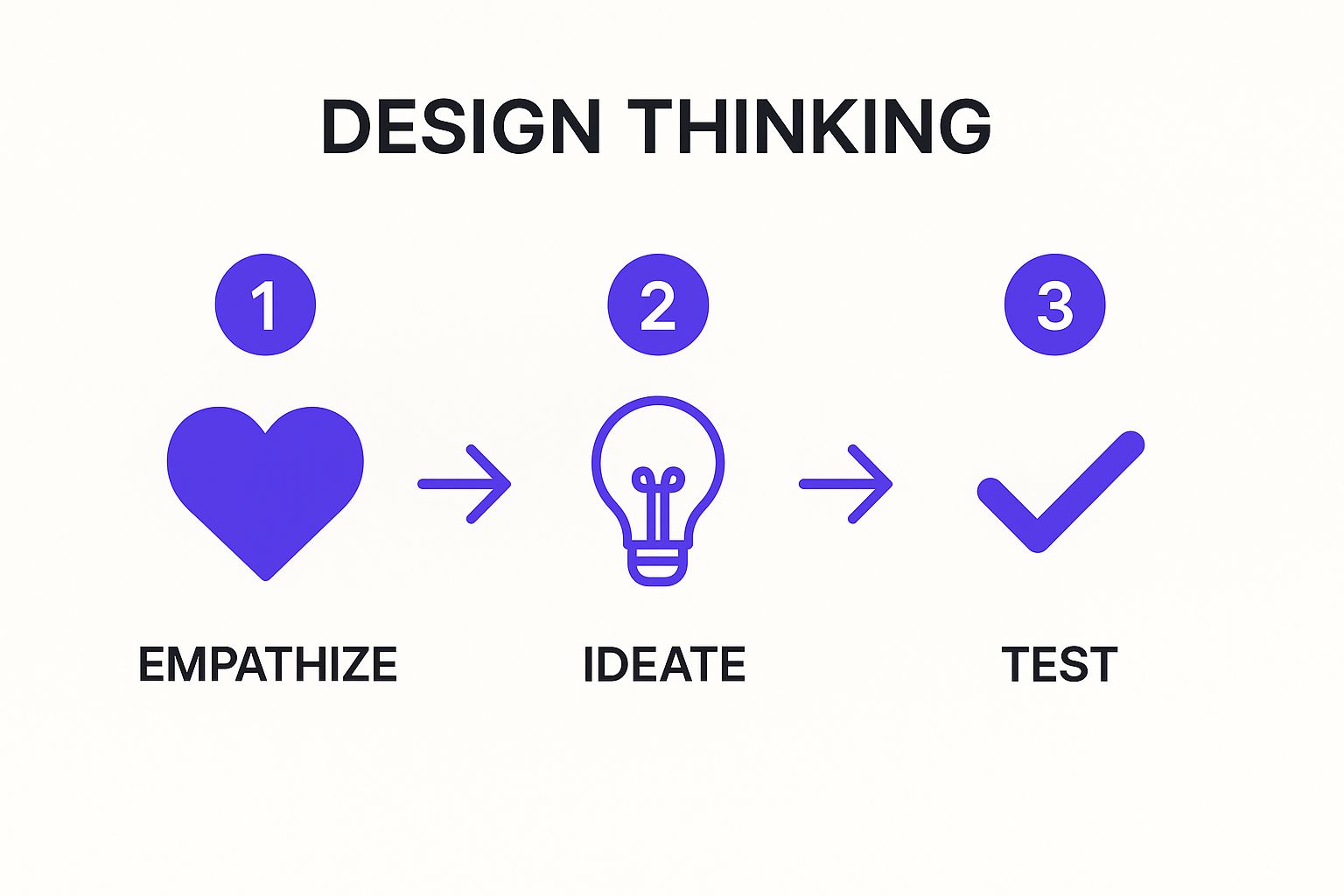
This flow highlights how starting with empathy, moving to ideation, and concluding with testing creates a user-focused feedback loop. For those looking to dive deeper into a structured approach to problem-solving and innovation, you can explore the steps of the Design Thinking process.
How to Implement Design Thinking with Your Remote Team
Applying Design Thinking remotely requires deliberate tools and facilitation to bridge physical distance while maintaining a deep connection with users and team members.
- Invest Time in the Empathy Phase: Use digital tools for user research. Conduct video interviews, use online surveys, and analyze user session recordings to build detailed empathy maps and user personas.
- Create Low-Fidelity Prototypes Quickly: Use collaborative whiteboarding tools like Miro or Mural to quickly sketch wireframes, storyboards, or service blueprints. The goal is to make ideas tangible without investing significant time or resources.
- Test with Real Users Early and Often: Share prototypes via video conferencing and screen-sharing sessions. Observe user interactions and gather direct feedback to inform the next iteration of your solution.
- Embrace Failure as a Learning Opportunity: Frame each test as an experiment. The goal is not to be right but to learn what works and what doesn't. Foster a culture where failed prototypes are celebrated as valuable insights.
To get a more comprehensive overview, learn more about the full Design Thinking process.
6. Lateral Thinking
Lateral thinking is a deliberate creative process that sidesteps conventional, step-by-step logic in favor of indirect and innovative approaches. Popularized by Edward de Bono, it involves disrupting established thought patterns and challenging underlying assumptions to uncover fresh perspectives. Instead of moving vertically down a single path, this technique encourages you to move sideways to explore new, often unexpected, avenues.
This approach is one of the most powerful techniques for creativity when facing deeply entrenched problems. For instance, Cirque du Soleil reimagined the circus by removing the animals and focusing on human artistry, creating an entirely new market. Similarly, Netflix disrupted the entertainment industry not by improving DVD rentals, but by shifting to a completely different model: streaming. Both are classic examples of challenging core assumptions to innovate.
How to Implement Lateral Thinking with Your Remote Team
Facilitating lateral thinking requires creating a space where challenging the status quo is not just allowed but encouraged. The goal is to break free from the team’s default problem-solving habits.
- Challenge Every Assumption: Start by listing all the "rules" or assumptions related to your problem. For example, if you're building a project management app, an assumption might be "it must have a task list." Ask your team: "What if it didn't?"
- Use Random Word Stimulation: Introduce a random, unrelated word (e.g., "cloud," "bicycle," "kitchen") into the session. The team's task is to find connections between that word and the problem you are trying to solve, forcing new mental pathways.
- Practice 'What If' Scenarios: Pose provocative "what if" questions that alter the reality of the problem. For instance, "What if our service was free, but we charged for a different element?" or "What if our target audience was children instead of adults?"
- Seek Unrelated Inspiration: Ask each team member to bring an example of a brilliant solution from a completely different industry. Discuss how the principles behind that solution could be applied to your current challenge.
7. TRIZ (Theory of Inventive Problem Solving)
TRIZ, a Russian acronym for the Theory of Inventive Problem Solving, is a systematic methodology for creativity based on the study of patterns across millions of patents. Developed by Genrich Altshuller, it provides tools and principles for solving complex technical problems by identifying and resolving contradictions. Instead of random ideation, TRIZ offers a structured path to innovation by applying universal principles found in past inventions.
The power of TRIZ lies in its logical, data-driven approach to what is often seen as an intuitive process. Companies like Samsung and Intel have used TRIZ to advance semiconductor and microprocessor technologies, while P&G applies its principles to develop innovative consumer products. This method transforms difficult challenges into solvable problems by using a database of proven solutions, making it one of the most powerful techniques for creativity in engineering and product design.
How to Implement TRIZ with Your Remote Team
Applying TRIZ requires a shift from brainstorming to structured problem analysis. It’s ideal for remote teams tackling well-defined technical or engineering challenges where innovative, non-obvious solutions are required.
- Identify the Core Contradiction: Start by clearly defining the problem as a contradiction. For example, "We need our device to be stronger, but making it stronger also makes it heavier."
- Use the 40 Inventive Principles: Consult the TRIZ framework to find which of the 40 inventive principles apply to your specific contradiction. Tools like the Contradiction Matrix can guide your team to relevant principles, such as Segmentation, Asymmetry, or a change in physical state.
- Focus on Ideal Final Result (IFR): Define the ideal solution without considering constraints. Ask, "What is the ultimate best outcome?" This helps the team bypass mental blocks and envision a breakthrough. To dig deeper, you can explore the creative problem-solving process for more structured approaches.
- Study Examples from Other Industries: Encourage the team to research how other fields solved similar contradictions. TRIZ is built on the idea that inventive solutions are universal and can be adapted.
8. Morphological Analysis
Morphological Analysis is a systematic technique for creativity that breaks a complex problem into its core dimensions. Developed by Swiss astronomer Fritz Zwicky, it involves listing variations for each dimension and then combining them in novel ways to explore every possible solution. This structured grid, often called a "Zwicky box," helps teams move beyond obvious answers and uncover innovative configurations they might have otherwise missed.
Its power lies in mapping the entire solution space, forcing a methodical exploration of new possibilities. For instance, NASA has used this method to explore design configurations for spacecraft, while automotive engineers might use it to generate new vehicle concepts by combining different engine types, body styles, and fuel sources. By systematically pairing attributes, teams can generate a vast number of ideas from a small set of components.
How to Implement Morphological Analysis with Your Remote Team
This method is ideal for distributed teams tackling complex product design or strategy problems, as it provides a clear, visual structure for collaboration.
- Define Core Dimensions: First, identify the fundamental parameters of your problem. For a new software application, dimensions could be "Data Source," "User Interface," "Monetization Model," and "Platform."
- List Variations for Each Dimension: Under each dimension, list all possible options or variations. For "Monetization Model," you might list "Subscription," "Freemium," "Ad-Supported," and "One-Time Purchase."
- Create a Combination Grid: Use a digital whiteboard to create a grid where rows represent dimensions and columns represent variations. The team can then systematically or randomly connect one variation from each dimension to generate a complete solution concept.
- Filter and Evaluate Combinations: After generating numerous combinations, establish criteria to filter the most promising ones. Discuss these top concepts in a follow-up session to assess feasibility and potential impact.
9. Synectics
Synectics is a creative problem-solving technique that makes the familiar strange and the strange familiar through the power of analogies and metaphors. Developed by William J.J. Gordon and George Prince, this method encourages teams to connect seemingly unrelated concepts to generate innovative solutions. It intentionally blends rational and irrational thinking, forcing the brain to forge new neural pathways by looking at a problem from a completely different perspective.
The power of Synectics lies in its ability to break mental fixedness. For example, the invention of Velcro was famously inspired by how burr seeds stuck to a dog’s fur, a direct biological analogy. Similarly, Procter & Gamble used this technique to design the stackable Pringles chip and its unique can, solving the problem of broken chips and greasy bags. This structured use of metaphor is a potent tool for sparking breakthroughs.
How to Implement Synectics with Your Remote Team
Synectics requires a guided approach to help your team explore metaphorical thinking effectively. A skilled facilitator is key to guiding the process and ensuring psychological safety for sharing abstract ideas.
- State the Problem and Generate Analogies: Clearly define the challenge. For instance, "How can we make our onboarding process more engaging?" Then, ask the team for direct analogies from nature or technology. A direct analogy might be, "How does a plant establish roots in a new environment?"
- Explore Personal and Symbolic Analogies: Dive deeper with personal analogies ("How would I feel if I were a new user?") or symbolic ones, which use images to describe the problem ("Describe the onboarding process using only two contrasting words, like 'smooth chaos'").
- Force a Connection: After exploring various metaphors, force a connection back to the original problem. Ask the team, "How can the idea of a plant establishing roots inspire new features for our onboarding process?"
- Allow for Incubation: Document all the metaphorical connections and ideas generated. Give the team time to reflect on these abstract concepts before reconvening to develop concrete solutions. This incubation period often helps solidify the most innovative ideas.
10. Random Word Technique
The Random Word Technique is a simple yet powerful method for shattering mental blocks and generating novel ideas. This approach, popularized by creativity experts like Edward de Bono, forces your brain to create connections between a randomly selected word and the problem you are trying to solve. This disruption of conventional thought patterns is one of the most effective techniques for creativity when you feel stuck.
Its strength lies in its ability to bypass logical, linear thinking and access more associative, imaginative parts of the brain. For instance, an advertising team trying to market a new sports drink might land on the random word "bridge." This could spark ideas about connecting athletes, bridging performance gaps, or creating a bridge to a healthier lifestyle. The technique forces you to look at your challenge from an entirely new and unexpected angle.
How to Implement the Random Word Technique with Your Remote Team
This method is perfect for quick, energetic virtual sessions designed to break creative deadlocks. It requires minimal setup and can easily be adapted for any online collaboration tool.
- Generate a Truly Random Word: Define your problem statement clearly. Then, use an online random word generator, or have a team member flip to a random page in a dictionary and point to a word. The more disconnected the word seems, the better.
- List Attributes and Associations: As a group, list everything you associate with the random word. If the word is "cloud," your list might include "soft," "storage," "floating," "data," and "weather."
- Force Connections: Systematically try to connect each attribute from your list to your problem. How can "soft" apply to improving customer service? How can the concept of "data storage" inspire a new product feature?
- Don't Censor Ideas: Encourage the team to voice every connection, no matter how absurd it seems. The goal is to generate a wide range of starting points that can be refined later. You can discover more ways to apply the Random Word Technique on remotesparks.com.
Techniques for Creativity: Comparison Overview
| Technique | Implementation Complexity 🔄 | Resource Requirements ⚡ | Expected Outcomes 📊 | Ideal Use Cases 💡 | Key Advantages ⭐ |
|---|---|---|---|---|---|
| Brainstorming | Low 🔄 | Minimal ⚡ | Large volume of ideas quickly 📊 | Early idea generation, team creativity 💡 | Encourages participation, cost-effective, team bonding ⭐ |
| Mind Mapping | Moderate 🔄 | Low to moderate ⚡ | Visual organization, enhanced memory 📊 | Understanding complex topics, note-taking 💡 | Reveals connections, supports multiple learning styles ⭐ |
| SCAMPER Technique | Low to moderate 🔄 | Minimal to moderate ⚡ | Practical, actionable ideas 📊 | Improving/modifying existing products/processes 💡 | Systematic innovation, reduces creative blocks ⭐ |
| Six Thinking Hats | Moderate 🔄 | Moderate ⚡ | Comprehensive perspectives, reduced group conflict 📊 | Group decision-making, complex problem solving 💡 | Structured thinking, increases participation ⭐ |
| Design Thinking | High 🔄 | High ⚡ | User-centered innovative solutions 📊 | Complex problems requiring user focus 💡 | Focus on real needs, rapid prototyping, multidisciplinary collaboration ⭐ |
| Lateral Thinking | Moderate 🔄 | Low ⚡ | Breakthrough, unconventional ideas 📊 | Challenging assumptions, innovation in any domain 💡 | Encourages radical ideas, breaks mental blocks ⭐ |
| TRIZ | High 🔄 | High ⚡ | Systematic technical innovation 📊 | Technical, engineering problem solving 💡 | Proven invention patterns, reduces trial/error ⭐ |
| Morphological Analysis | High 🔄 | Moderate ⚡ | Comprehensive solution space coverage 📊 | Complex problem solving, system architecture 💡 | Systematic exploration, objective alternative comparison ⭐ |
| Synectics | Moderate to high 🔄 | Moderate ⚡ | Innovative, metaphor-based solutions 📊 | Complex, ill-defined problems 💡 | Combines rational and emotional thinking ⭐ |
| Random Word Technique | Low 🔄 | Minimal ⚡ | Unexpected creative directions 📊 | Breaking mental blocks, sparking ideas anywhere 💡 | Simple, quick, cost-free, flexible ⭐ |
From Technique to Transformation: Systematizing Your Creative Process
We've explored a powerful arsenal of ten distinct techniques for creativity, from the structured logic of SCAMPER and the Six Thinking Hats to the imaginative leaps of Synectics and the Random Word method. Each offers a unique pathway to break through conventional thinking, but their true power isn't in their isolated application. The goal is to move beyond occasional creative sparks and build a reliable, systematic engine for innovation within your team.
Mastering these methods is less about memorizing steps and more about cultivating a new mindset. It’s about understanding that creativity isn’t a mystical gift but a skill that can be developed, practiced, and deployed on demand. By integrating these frameworks into your workflow, you provide your team with a shared language and a structured process for tackling complex challenges, ensuring that even remote collaboration can produce groundbreaking ideas.
Key Takeaways for Your Team
The journey from learning these techniques to achieving consistent innovation involves a few crucial steps:
- Start Small, Experiment Often: Don't try to implement all ten methods at once. Choose one or two, like Mind Mapping for initial discovery or SCAMPER for product iteration, that align with a current project. Run a low-stakes session and gather feedback.
- Create Psychological Safety: True creativity requires vulnerability. Ensure your team environment, especially in a remote setting, encourages wild ideas without fear of judgment. The structure provided by methods like the Six Thinking Hats is excellent for this, as it separates ego from ideas.
- Focus on the Process, Not Just the Outcome: The objective is to build a repeatable creative habit. Celebrate the process of exploration itself. Sometimes the most valuable outcome of a session isn't a single "winning" idea but the collective muscle memory your team develops for innovative thinking.
Actionable Next Steps to Systematize Creativity
To turn these concepts into concrete actions, begin with a deliberate plan. Schedule a dedicated session with your team to try one of the simpler techniques for creativity, like Brainstorming with clear constraints or applying the Random Word method to a minor challenge. As your team grows more comfortable, you can introduce more complex frameworks like Design Thinking for user-centered problems or TRIZ for deep technical hurdles. For those looking to broaden their toolkit beyond the techniques mentioned here, explore these additional 10 powerful creative problem-solving methods to find even more frameworks that suit your team's unique needs.
Ultimately, the most significant transformation occurs when these practices become second nature. When your team instinctively reaches for a creative tool to unblock a problem, you have successfully built a culture of sustained innovation. This is where a structured approach proves its worth, turning abstract potential into measurable results and empowering every team member to contribute their most imaginative solutions.
Ready to put these techniques into action with a tool designed for remote teams? Bulby provides guided workflows based on proven creative frameworks, eliminating guesswork and making every session productive. Transform your team’s creative potential into tangible innovation by trying Bulby today.
